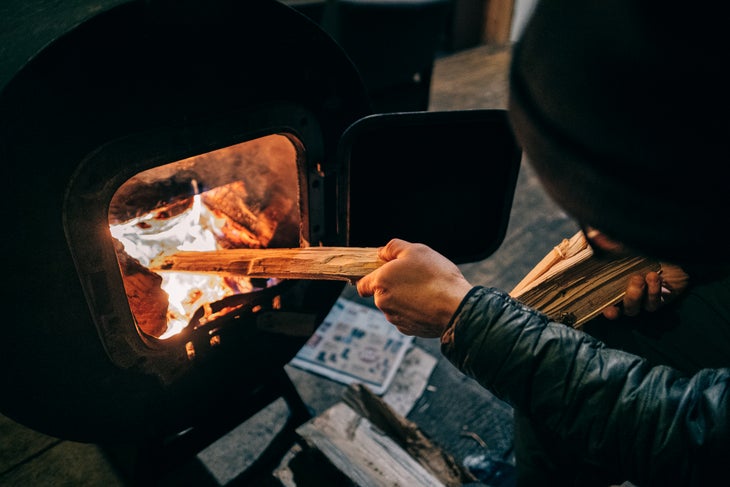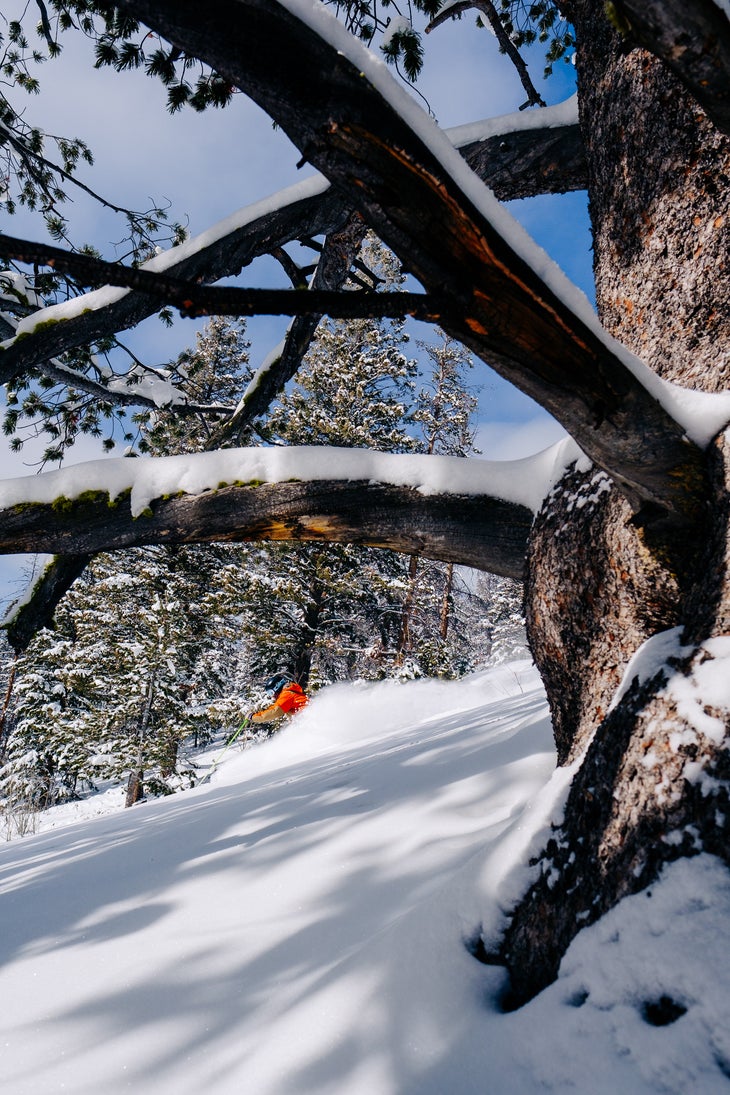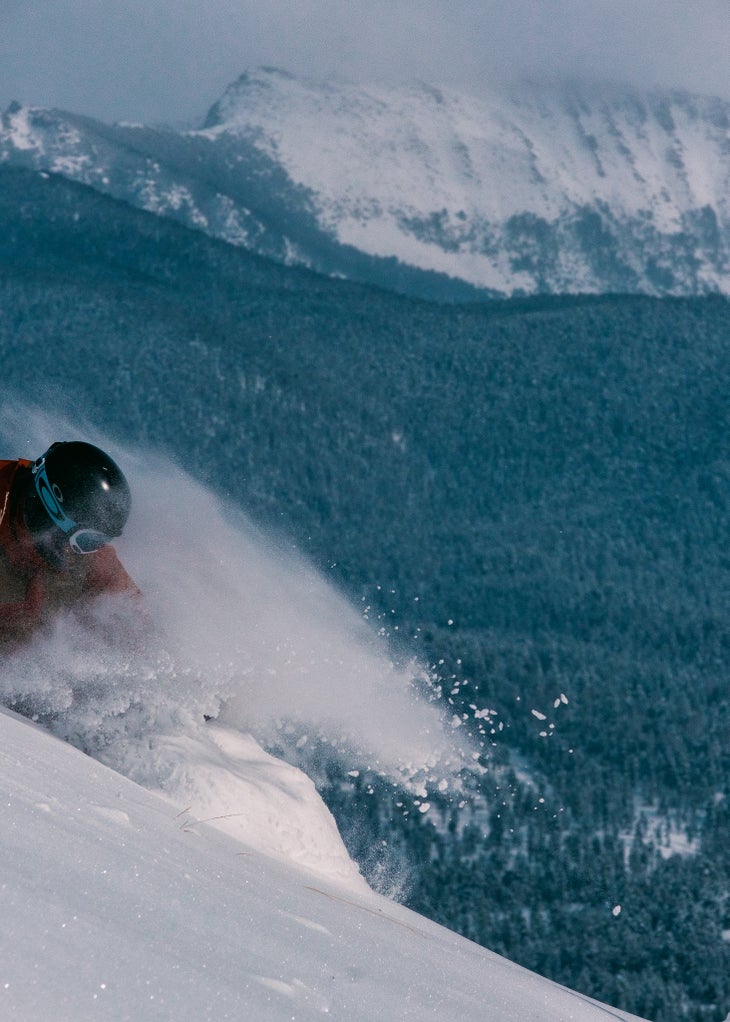Heading out the door? Read this article on the new Outside+ app available now on iOS devices for members! Download the app.
The man who’d just climbed into the hot springs pool with us floated a frozen gallon of milk in the water and lined up a half-dozen cans of beer on the pool’s edge. This, he claimed to my ski buddy Cory and me, was the key to longevity. It was not quite 8:30 in the morning, and Cory and I had a long day of skiing at southwest Montana’s Maverick Mountain Ski Area ahead of us; dark beer and a life buoy of half-thawed whole milk didn’t seem like the key to surviving the rest of the day, let alone a long lifespan. Cory, a Maverick local, referred to this part of the state as the Powder Triangle, and it was already doing its best to maroon us.
I’d met Cory Birkenbuel a few years prior during a visit to Maverick. Born and raised in Dillon, the only town of any size in this part of the state—his mom patrolled and taught lessons, and his dad ran the lift, the groomer, and drove the ski bus—Cory is perhaps the ski area’s biggest ambassador and the closest the hill has to a sponsored athlete. When the odd pro or clueless journalist wanders up to Maverick, Cory gives them a dose of the “Maverick Magic.”

The mountain had bewitched me on that first trip. On a subsequent visit, Cory proposed a road trip to the three small ski hills—Maverick Mountain, Discovery Ski Area, and Lost Trail Powder Mountain—that form Southwest Montana’s Powder Triangle. Here, the ski areas, like the ranches, span multiple generations of family owners, offering a corrective to the corporate monoculture of modern ski resorts. Our plan: spend four days drinking beers in thermal hot springs, driving two-lane backcountry blacktop in whiteout conditions, and, of course, skiing deep, dry powder.
Keep Reading: Have You Skied The 7 Biggest Ski Resorts in North America?
We’d arrived at Elkhorn Hot Springs late the night before. The resort dates back over a century, tucked in a cold-trapping canyon in the shadow of the 11,000-foot peaks of the Pioneer Mountains. Sub-zero temperatures had settled into the uninsulated wood walls of our rustic cabin, and stoking a small fire in the barrel-shaped wood stove did little to ward off the chill. I slept in my base layers under six quilts but awoke refreshed from a sleep that can only be found far from modern comforts.

After leaving our new friends and their floating protein shake at Elkhorn, we arrived at the hill. As the crow flies, it’s less than a hundred miles from Maverick Mountain to the iconic Big Sky Resort. Culturally, Maverick couldn’t be further from that mega-resort; for one thing, it has 100 percent more wood paneling on the walls and denim on the slopes. Proudly mom-and-pop, Maverick is the sort of place where ski industry cynicism dissipates in the steam of slow-cooker potluck suppers. Over the years, at least one local old-timer has negotiated a $1 per lift ride arrangement to sneak in a single lap before the day’s farm chores—paid on the honor system, of course.
A single rope tow and two-seater center-pole Riblet chair serve Maverick’s 255 acres. But despite being a bluebird Saturday with six inches of new snowfall, the lift line never stretched more than a chair or two, just enough time for Cory to chat up friends.
Maverick’s season had gotten off to a slow start, but the underlying terrain, a mix of low sagebrush and bunchgrass typical of the east slope of the Continental Divide, allowed us to maximize the previous night’s powder harvest, slashing turns under the outstretched branches of burly firs in the Enchanted Forest.

We left Maverick late in the afternoon under a graying sky, our destination, the town of Jackson, across the Beaverhead Mountains. As we drove over the low pass, skiffs of wind-driven snow blew through barbed-wire fences and drifted across the two-lane blacktop. In 30 miles of highway, not a single car passed us in either direction.
Little has changed in this part of the state since prospectors struck Montana’s first major gold discovery in nearby Bannack in 1862, setting off a gold rush that swelled the settlement to some 3,000 people in a year. (Today, Bannack State Park preserves the town, which, in true gold-rush fashion, went bust just as quickly.) Hay and cattle production dominate the economy and coffee-shop conversation alike, but the region’s blue-ribbon fly-fishing rivers and high, glaciated peaks have begun to attract the eye of increasing numbers of recreationists. The Big Hole Valley, the sprawling sea of grass in which Jackson sits, earned the nickname “The Valley of 10,000 Haystacks” for its impressive yields. We hoped that the name the Native Americans traveling through the area called, “The Land of Big Snows,” would produce for us too.
More Montana Reading: 5 Resorts Where You Can Ski Across the Border
The tiny community of Jackson owes its growing reputation as a winter sports basecamp to those big snows and the steam (it’s one of North America’s hottest thermal springs). The warmth extends into the wood-paneled charm of Jackson Hot Springs Lodge, our accommodations for the nights, where, as would become a recurring theme, Cory ran into long-lost friends. We ended the day as we began it, with cold drinks lined up on the ledge of a steaming hot spring (thankfully, sans milk).
The next morning, ski legs refreshed from the water and my head only mildly ringing from the drinks, we departed for our second ski stop, Lost Trail Pass.
Named for an arduous detour the Corps of Discovery’s William Clark and his Shoshone guide took around the impassable canyons of the Salmon River in their journey across the Rockies, Lost Trail Pass straddles the serrated granite spine of the Bitterroot Crest as well as the Idaho / Montana border, offering views over some of the most remote country in North America. Although it’s only 90 miles from the college town of Missoula, the ski area still maintains its rustic roots. In the lodge, gloves exhale steam next to a wood stove, and lift tickets remain reasonably priced. (And as both homesteaders and college-town hippies can appreciate, Lost Trail operates completely off-grid.)
The resort’s 1,800 acres stretch along the steep, east-facing glades of the Bitterroot Crest, but a series of surface tows make the traverses a lot easier than the Corps of Discovery had it. But skiers don’t have to travel far afield for the goods, either: the show-off steeps of North Face and the double-black granite chutes of Outlaw lie almost directly under Chair 1. Cory and I snagged the low-hanging fruit of those chutes before working our way to the White House glades at the north end of the ski area, where we managed to find untracked lines up until the closing bell.
Negotiating an untracked highway, we arrived late in Philipsburg. During its silver-mining streak, Philipsburg counted only four women and four children among more than six hundred residents. Today, the community is decidedly more family-friendly. And so is its home hill, Discovery Ski Area. “Disco,” as it’s affectionately known, is still a family-owned business, where the president is on a first-name basis with the regulars and school buses unload local children for ski lessons. On the steep gullies and glades of the backside of the mountain, though, the skiing retains the rough-and-tumble feel of the region’s mining heyday.

The next morning, we rolled into the lodge just as a busload of schoolchildren crowded the cafeteria. Quickly escaping the sea of sack lunches, Cory and I headed straight for the Limelight chair, the two-seater which serves the north side of the mountain.
We hunted lines among the crooked forms of dormant larch trees, but when the snow started falling in earnest at lunchtime, we bee-lined it for the wide avenue of double-black Manhattan, the fresh snow covering our tracks each lap and then some. The lifts stopped before the snow did, and it took an effort to resist the urge to postpone the drive home in favor of another deep day.
After my three days exploring this rugged area of the state, with several hazy evenings, one thing remained clear. Although any relation to the Bermuda Triangle is surely unintended, it’s just as easy to lose yourself here.
